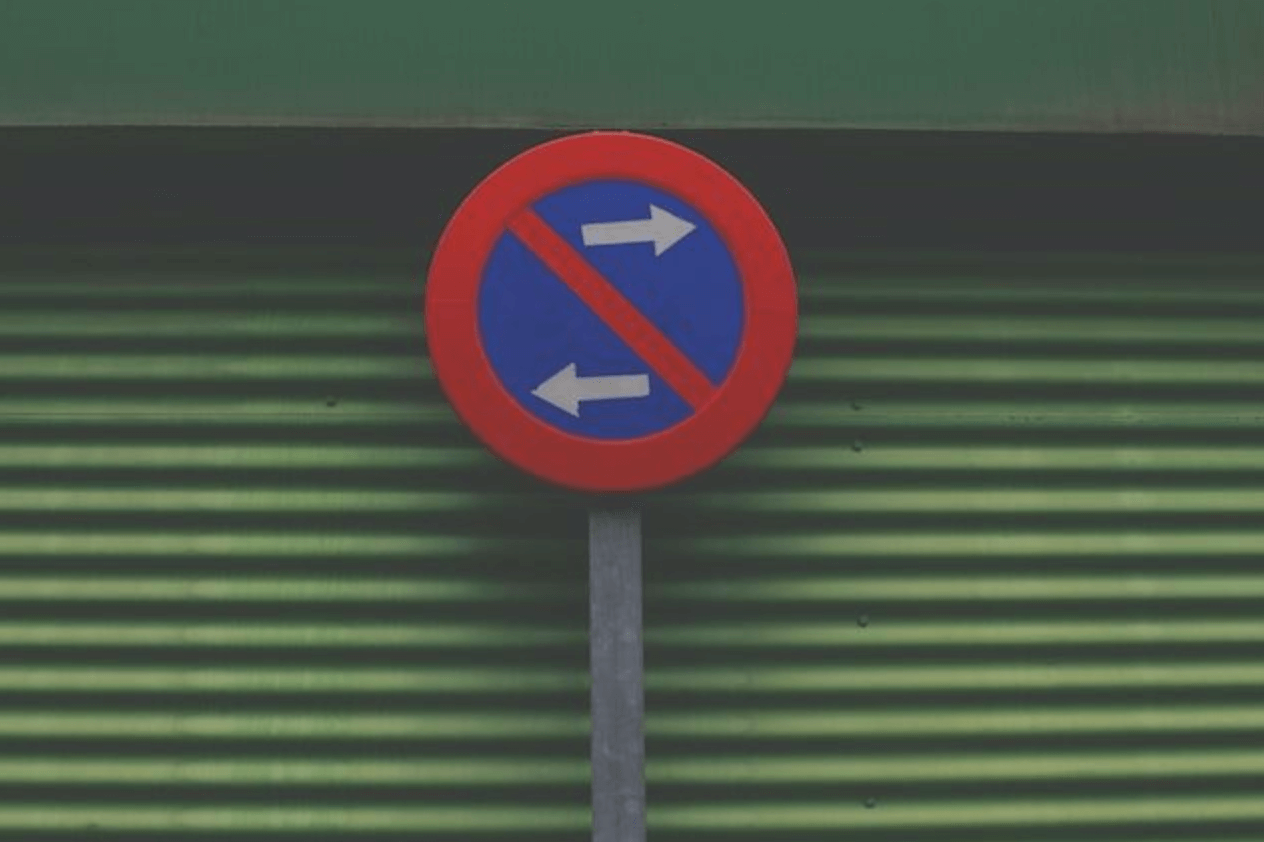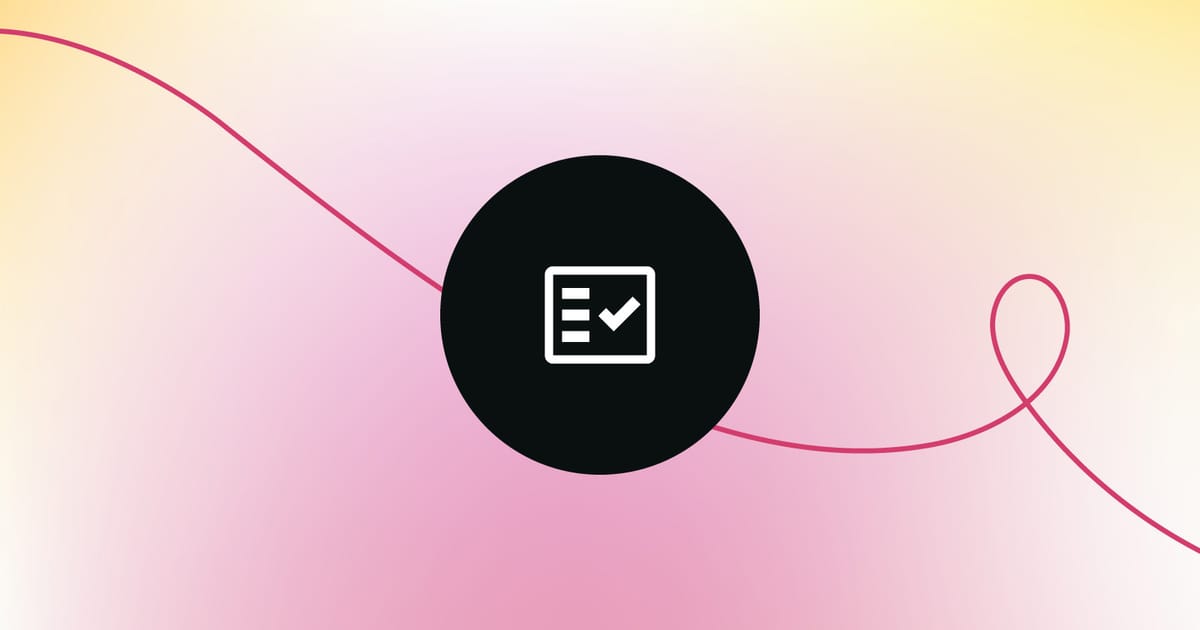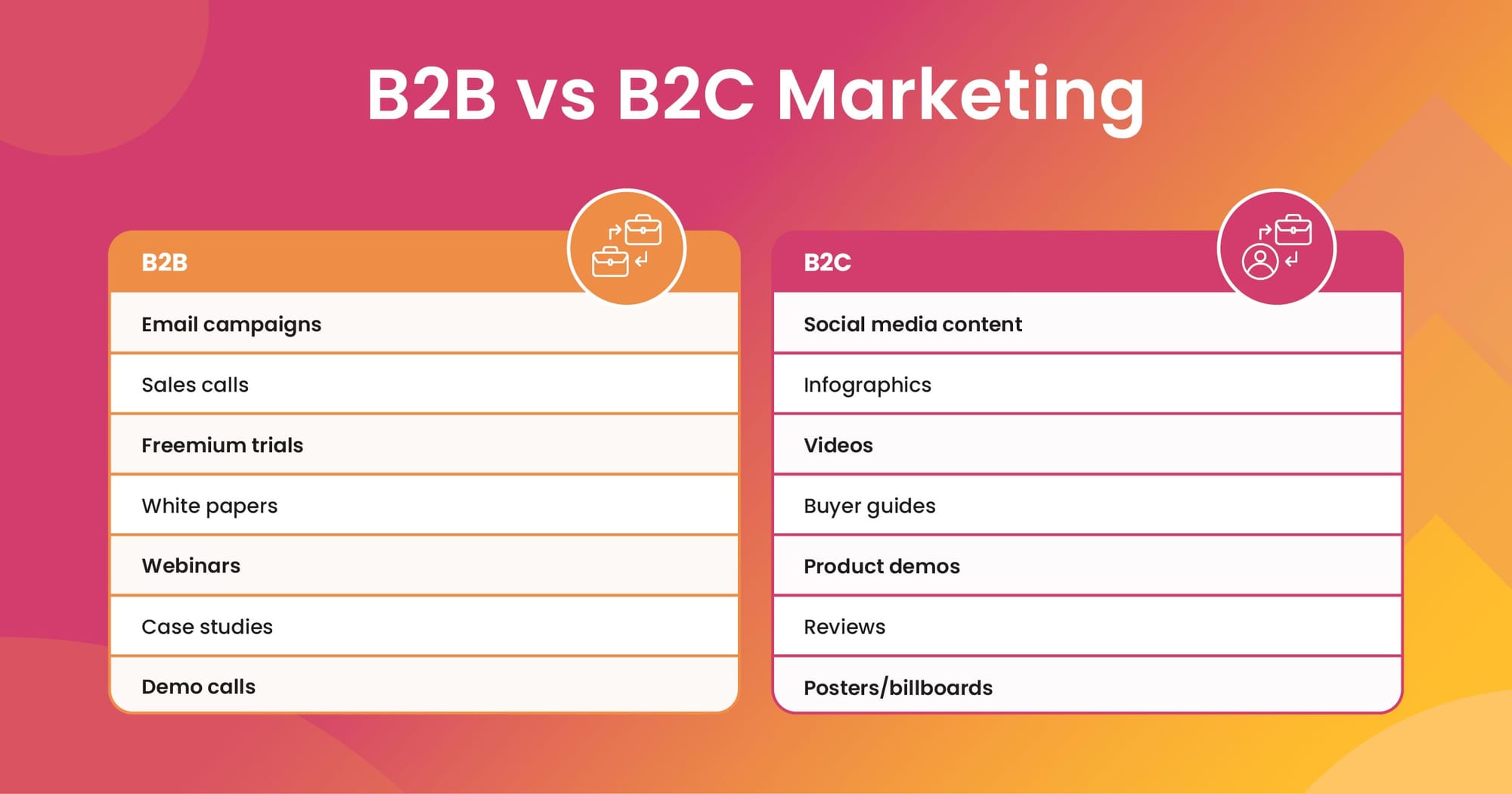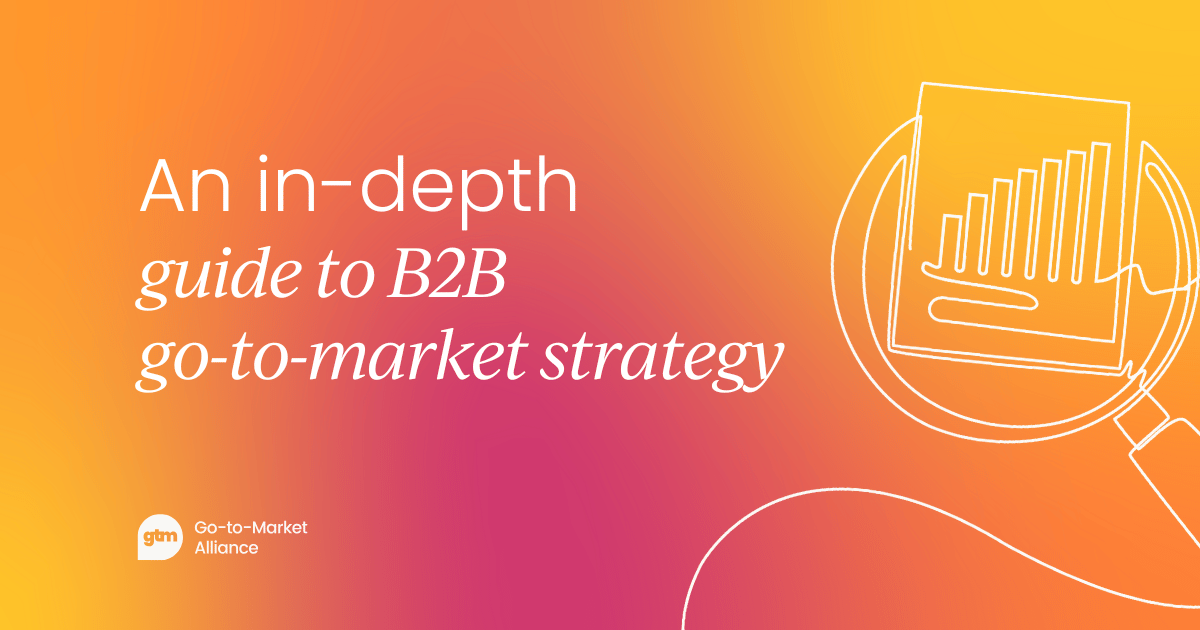When we’re talking about products, how can we not talk about the consumer?
Who you’re selling to has an impact on every step in your Go-to-Market strategy from how you position the product to your messaging and how you develop your pricing and sales strategies.
But what are the different types of audiences? And how do you change your strategy to suit your target market or customer?
Well, keep reading if you want to know more about
- What the difference between B2B and B2C is,
- How to market for B2B vs B2C,
- And how your audience affects your Go-to-Market strategy.
B2B and B2C: what’s the difference?
Though both these terms relate to how businesses sell, there’s a slight difference in customers.
But how exactly are these two selling techniques different?
- Different approaches to customer relationship building: B2B and B2C businesses have different priorities, sell different products, and, therefore, require different selling and marketing methods. For example, in B2B, you’ll want to focus on clear product positioning and branding to really speak to your customers' pain points. It’s about developing deeper customer relationships. On the other hand, B2C is more concerned with marketing directly to the individual customer (as B2C is more transactional).
- Different focus on buyer decision-making process: an extension of the above point, because both selling approaches target different aspects of the buyer journey, the customer decision process will vary. So, for B2B, sales cycles might take a lot longer than in B2C, where companies focus more on making the buyer decision-making process a lot simpler and straightforward.
- Target audiences: B2B selling will typically be companies that are selling software solutions to other businesses. Or they might be selling physical products, but at a wholesale level. So, customers are usually looking to make purchases on behalf of an entire business. B2C, on the other hand, involves a more traditional business-to-consumer, funnel-focused selling where the individual buyer is at the center of the selling method.

We’ll dive a little deeper into each of these points now, so let’s get into it.
B2B
It's not just about one-off purchases.
B2B businesses have to prioritize ROI.
It’s crucial for B2B businesses to think not just about long-term relationships with buyers and the customer’s lifetime value but also how much money a decision will bring back to the company over the next few years.
At the heart of good B2B marketing and selling is your positioning and your brand’s ability to sustain healthy customer relationships. To elevate the customer voice in your sales strategy, consider conducting a SWOT analysis or setting up feedback loops.
Why?
Well, your customers will typically be doing a lot more research into you and your products before a decision is made. And, likely, there won’t just be one decision maker. Instead, a series of people will have to agree before a purchase is made.

And that means your business must hold up against a certain level of scrutiny.
Unsurprisingly, this also affects how you sell. The more expensive a product, the more thought is given to whether a business will purchase the product or not.
Another reason why customers might take a while coming to a decision is that, with B2B, products are rarely one size fits all. There should be room for custom packages and a negotiable price point even though this results in a longer sales cycle.
Now, B2B SaaS companies often sell products that are suited to subscription-based models that keep customers coming back year after year. But to keep them coming back, you have to make sure you keep making those products worth it. If you don’t, your customers will look elsewhere.

B2C
B2C businesses have to sell their product to hundreds and thousands of individuals and find a way to make their brand resonate with all of them.
Unlike B2B - where business can take their time building lasting relationships with users - B2C needs to be more careful with the product branding. Marketing needs to be razor-sharp and memorable so customers can easily spot a brand they trust from ones they might not be familiar with.
So it really comes down to (a) how you market your business in a B2C model and (b) how you build a brand that customers resonate with at an individual level.
When trying to come up with inventive copy, ads, or marketing campaigns that resonate with your buyers, remember:
- Customers research products before they buy them, but they also make impulse purchases or purchases based on gut feelings rather than logic. B2C marketing has to appeal to that impulsive, emotional side of the buyer, which means your marketing can be more playful. However, getting this right comes down to your tone of voice and a market position that appeals to what your buyers care about.
- Individual buyers are far less willing to sit through a sales call, so B2C selling works better with self-serve models. In other words, your marketing needs to take the buyer through the stages of the sales funnel in a clear and concise way.
- Business jargon will typically alienate B2C customers. Although people often assume it's best to be colloquial with B2C and formal with B2B, nothing’s ever that black and white. For example, if you’re selling life insurance, your message should be clear, accessible, and professional. You want buyers to understand your product always. Keep things simple where possible!
How to market for B2B vs B2C
You might be wondering how to specifically market to customers or finetune your go-to-market approach based on your unique audience. Ultimately, how you’ll market your product to users (irrespective of approach) requires different marketing strategies and channels.
When it comes to B2B, your main marketing channels will be:
- Email campaigns.
- Sales calls.
- Freemium trials.
- White papers.
- Webinars.
- Case studies.
- Demo calls.
And, for B2C, the most popular are:
- Social media content.
- Infographics.
- Videos.
- Buyer guides.
- Product demos.
- Reviews.
- Posters/billboards.

Although social media is usually associated with B2C marketing, that doesn’t mean B2B companies should look the other way. Often these two might intersect and one marketing approach could very well apply to B2B as much as B2C.
When developing a clear marketing strategy, ask yourself:
- How can I effectively carry out social media marketing for B2B?
- How do I use social media to reach businesses, or balance my positioning and messaging with the style of content social platforms demand?
- How do I make sure I match the increasing demands of today’s modern buyer, or pivot my strategies to speak directly to my customers’ needs?

The impact of B2B and B2C selling on your Go-to-Market strategy
How you launch your products is directly influenced by who they’re for.
Let’s look at a few GTM essentials and how your audience can affect the whole or parts of your launch strategy.
Product roadmaps
If you’re selling to a business, remember that they’re going to be doing a lot of research about you and asking questions about the future of your product:
- What features will you be adding?
- When will updates be rolled out?
- Is your product going to be the best solution for their problems?
A product roadmap shows them where you’re headed and how you’ll continue to deliver value for them.
An individual buyer isn’t going to be researching your product plans years into the future; they’re more likely to be focused on the here and now. But they will want to know they’re getting a product that isn’t going to be outdated in the next year, so try and think ahead with your products and make sure you’re not launching something soon to be obsolete.
Positioning and messaging
When it comes to positioning, you need to consider your customer needs. Do users want you to be authoritative? Climate-friendly? Tech-savvy?
Once you’ve got your positioning nailed down, think of how to distribute your messaging.
You’ll want to use different channels for different audiences. B2B businesses have to provide a lot of technical information, so they’re better off with marketing formats that make it easy to get a lot of information across.
Meanwhile, with B2C, you’re speaking to an individual and often to that gut feeling that tells them this product will make their lives better. More specifically, you’re showing customers the life they’ll have with your product and asking them to buy that fantasy. This is why the most effective channels for B2C marketing are social media, video content, and influencer marketing. But for the more discerning consumer who is weighing up their options, buyer guides and digital/video brochures are also effective.
Again, it’s important to remember the more a product costs, the more time a customer will spend on the decision. What it usually boils down to is value for money.
And, as always, bear your specific audience in mind. Work out where your audience is and meet them there through appropriate marketing campaigns.
Pricing strategy
For B2B businesses, pricing can be more tailor-made for customers, especially if you’re using a sales-led Go-to-Market strategy where the sales team is getting a lot of face time with the prospective buyers. You can negotiate with the individual client and make sure you’re getting the most out of deals without alienating customers with a smaller budget.
For B2C, your pricing isn’t going to be negotiable, so you need to find other ways to be tactical. There’s a lot of psychology behind your pricing. Go too high and people will think it's a rip-off, go too low and you may be perceived as tacky or low quality.
It’s important to pick a price point that consolidates your positioning and feels worth it to your customers.
Distribution
Back in the good ol’ days, you walked into the store, picked the product you wanted from the two or three options available, and that was that.
Now, there are infinite options and we increasingly order online. And there are more and more products that have gone digital, which means customers interact with them very differently.
So, what is the best way to distribute your product?
One of the most important things for all of us is convenience. If you’re in B2C, what’s the easiest way to get a product in the hands of your buyer? If you’re exclusively selling online, find ways for customers to try before they buy with demos or offer trial periods (which are especially good for digital products).
A lot of B2C brands now use social media to share demo videos of their products, presented as ‘unboxings,’ so customers can feel confident in what they’re getting. Plus, when customers purchase products, they’ll usually want to solve problems for themselves rather than spend hours on hold, so make it easy for them to get answers to questions with FAQ pages. And if they do need help, chatbots or customer service teams that can be accessed via email are a lot more convenient for most people.
The key takeaways are to ensure information about products is easy to access, ordering and returning products is straightforward and customer service is effective.
But what about B2B?
Well, it does still come back to convenience. If you’re selling digital products, you'll probably do so online. Freemium models work well because clients can try the product out and then upgrade to the premium option. If they do need a nudge in the right direction, making answers to questions and sales reps readily available is still key.
With B2B, we’re increasingly seeing distribution strategies that allow you to get more creative. For example, you can build a Go-to-Market ecosystem. In an ecosystem model, you team up with other businesses that provide services you can’t but are complementary to your service. You build out an ‘ecosystem’ of services where customers can find all the parts they need in one neat package rather than having to piece solutions together for themselves.
This is far more convenient for the customer and gives you a competitive edge in terms of pricing (if you can offer bundle deals).

Customer service is also a big part of B2B distribution, although in this context it's more commonly referred to as a customer success function. B2B products are typically more complex and technical than B2C so, for customers to get the most value out of them, they’ll need to be onboarded.
If someone buys an iPhone, you can pretty much leave them to figure it out on their own. And if they get stuck, they’ll just pester the nearest Gen Z family member to set it up for them. But if you’re selling a complicated SaaS product that’s being rolled out across a whole company, that probably won’t cut it.
Having a customer success team to carry out an onboarding strategy, monitor retention and churn, and check in on customer satisfaction at pinch points (like when a subscription needs renewing) is crucial for most B2B customers.
As we’ve said, B2B businesses tend to build relationships with clients when they’re negotiating on price and product offerings. To maximize customer lifetime value, that relationship has to continue into the distribution and customer success stages of Go-to-Market.
To sum up
When it comes to B2B and B2C Go-to-Market, each customer will have different needs, problems, and priorities.
But the core values of the customer, like wanting to get a fair deal, convenient solutions, accessible information, and a seller they can trust, are applicable to both these models.
Whichever market you’re catering to with your Go-to-Market strategy, the most important questions to ask yourself are:
- What does this customer want?
- How do I solve their problem?
You’ll find that knowing the answers to these core questions can inform and help you conceptualize go-to-market strategies that’ll succeed.







